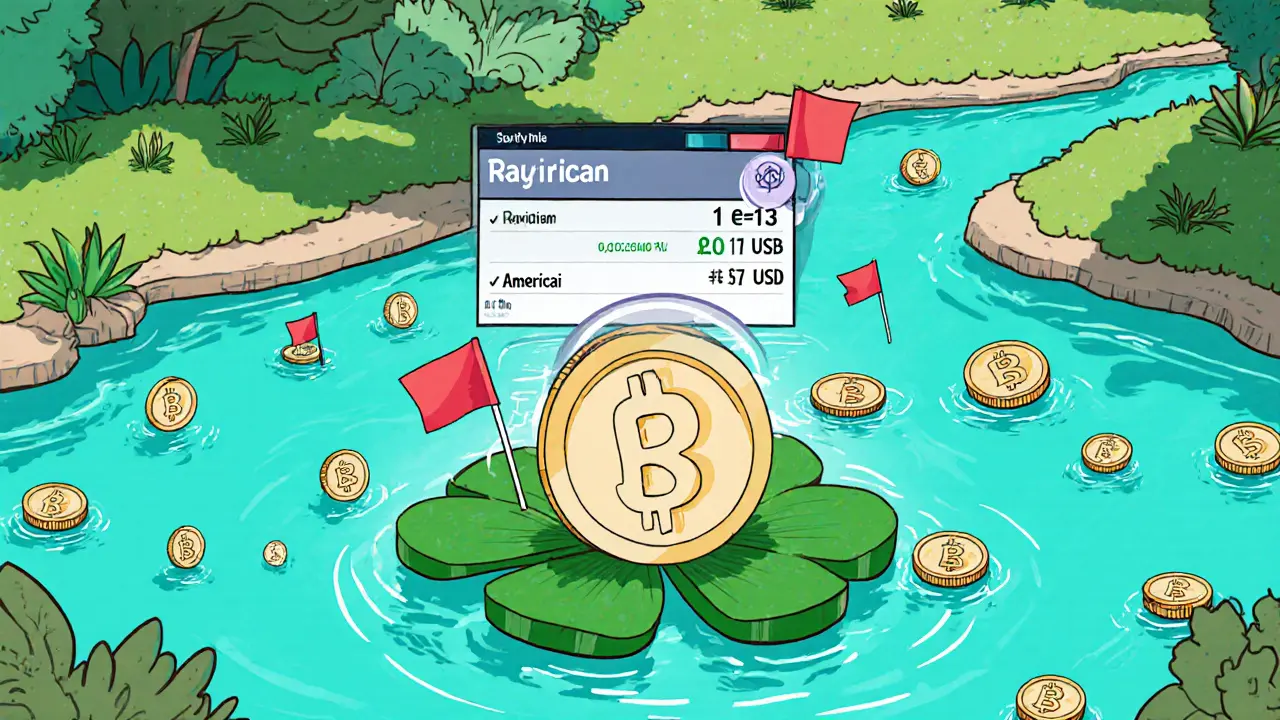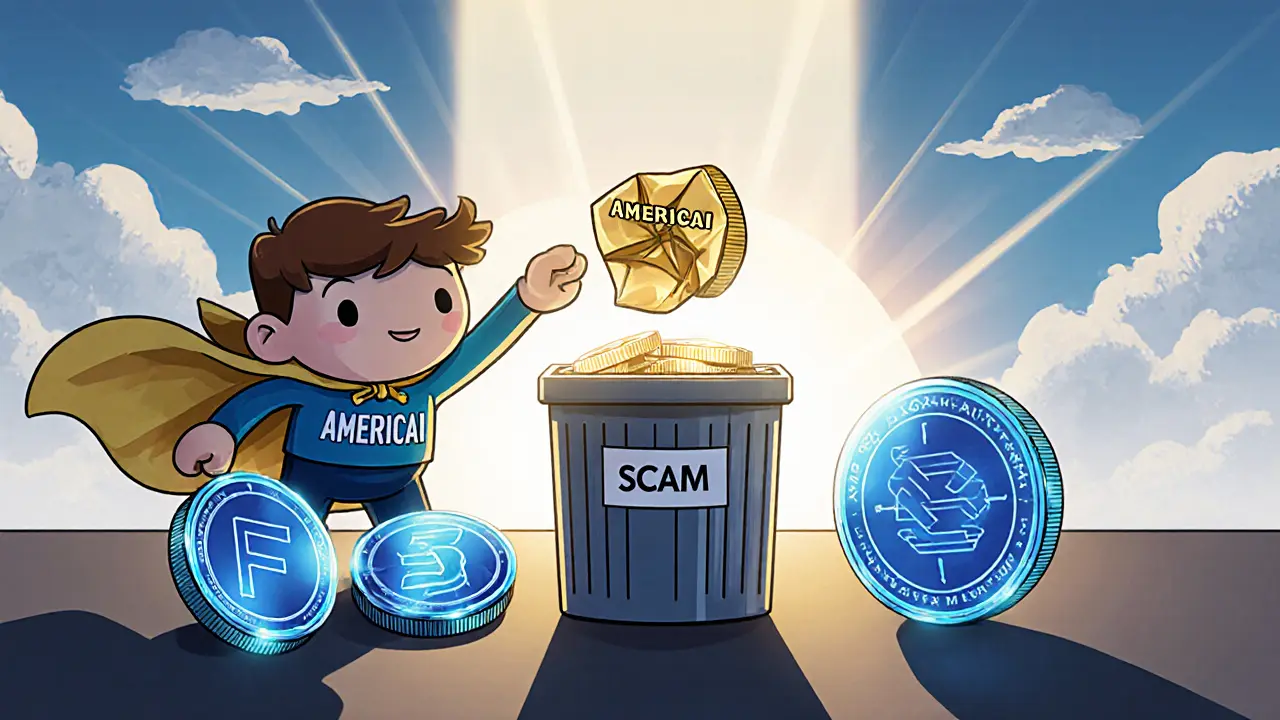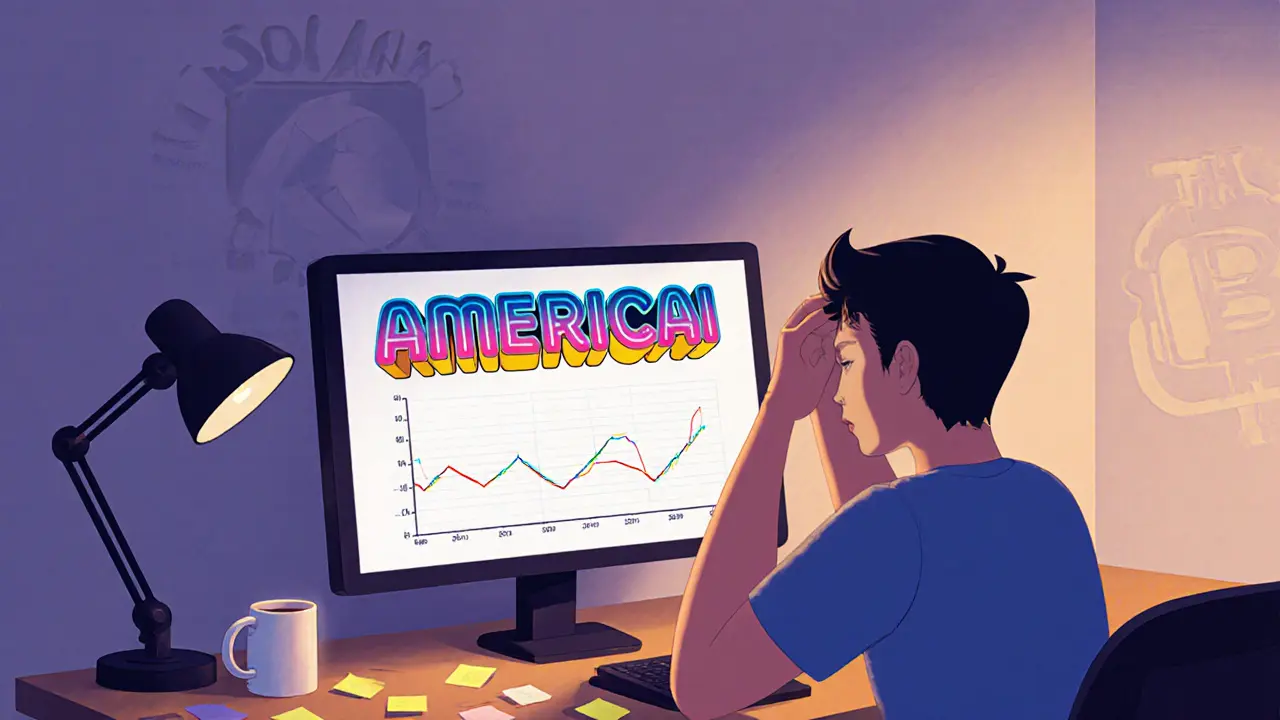AMERICAI Transaction Cost Calculator
How much does sending AMERICAI cost?
Based on current Solana transaction fees ($0.00025) and AMERICAI's value (1.51e-13 USD), this calculator shows how many tokens you'd need to send to cover the fee and the percentage loss.
Enter token amount to see fee calculation
Ever stumbled on a token that claims to be the next AI‑powered money but looks more like a typo? That’s the vibe most people get when they first see AMERICAI crypto coin. In this guide we break down what the token actually is, where it lives, how (or why) it trades, and whether it’s worth a second glance.
What Is AMERICA AI Agent (AMERICAI)?
AMERICA AI Agent (AMERICAI) is a governance‑oriented cryptocurrency built on the Solana blockchain. It was advertised as a way for token holders to vote on ecosystem decisions, but the project lacks any public whitepaper, GitHub repo, or active community channels.
Where Does AMERICAI Live?
The token runs on Solana, a high‑throughput chain known for sub‑second finality and low fees (about $0.00025 per transaction). In theory that makes it cheap to move tiny amounts, but in practice the token’s value is so low that a single transaction fee dwarfs the entire holding.
Trading pairs exist mainly on Raydium, a decentralized exchange (DEX) that operates on Solana, and sporadically on Binance’s spot market. Both listings show minuscule volume and price that hovers around 1e‑13USD - effectively zero.
Market Snapshot (October2025)
| Token | Launch Year | Blockchain | Current Price (USD) | Market Cap (USD) | 24‑h Volume (USD) |
|---|---|---|---|---|---|
| AMERICAI | 2025 (claimed) | Solana | 0.000000000000151 | ≈$3,000 | ≈$1.64 (Raydium) |
| UNI (Uniswap) | 2020 | Ethereum | 5.12 | ≈$3.2B | ≈$200M |
| MKR (MakerDAO) | 2017 | Ethereum | 1,150 | ≈$1.1B | ≈$30M |
Notice the stark differences: AMERICAI’s price and market cap are several orders of magnitude lower, and its 24‑hour volume barely covers a single coffee.
How Does Governance Work (If at All)?
The token’s description on CoinPaprika says it “enhances user engagement and decision‑making participation.” However, no DAO smart contracts are visible on Solana explorers, and there’s no public voting portal. In contrast, UNI and MKR both have dedicated governance frameworks where token holders can propose and vote on protocol upgrades.

Red Flags You Can’t Ignore
- Future‑dated launch: Coinbase lists the launch year as 2025, even though the token was already trading in 2023. That inconsistency suggests misinformation or deliberate hype.
- No whitepaper or code: A legitimate project usually has a publicly available whitepaper, GitHub repo, or at least a roadmap. AMERICAI has none.
- Price anomalies: Different exchanges report wildly varying prices for the same token within minutes, indicating thin liquidity and possible price manipulation.
- Negative community sentiment: Reddit threads, Bitcointalk warnings, and Binance chat logs all label the token as a “scam” or “worthless.”
- Regulatory risk: The SEC has been cracking down on tokens with opaque origins. A token that can’t prove its team or purpose is a prime target for enforcement.
Who Might Still Buy AMERICAI?
The only plausible buyer is a speculative trader chasing “penny tokens” hoping for a sudden pump. Some users are attracted to the ultra‑low price because they can buy millions of tokens for a few cents. That strategy rarely works-most micro‑cap tokens vanish after a brief hype cycle.
Practical Steps If You Already Own AMERICAI
- Check the token’s balance on a Solana wallet (e.g., Phantom or Solflare).
- Verify the contract address on Solscan to ensure you’re not holding a fake token.
- Attempt a swap on Raydium; if the transaction fails due to high fees, consider moving the tokens to a cold wallet for safekeeping.
- Monitor the 24‑hour volume on CoinMarketCap; if it stays below $5, the token is effectively illiquid.
- Decide whether to hold for a possible future pump or to write‑off the loss and move on.

Comparing AMERICAI to Legitimate AI‑Focused Tokens
Projects like Fetch.ai (FET) and SingularityNET (AGIX) actually build AI‑related infrastructure on blockchain. They have active development teams, clear roadmaps, and partnerships with real‑world AI firms. AMERICAI, by contrast, offers no AI product, no integration, and no usable technology.
Is AMERICAI a Scam?
While we can’t label any token illegal without a regulator’s ruling, the evidence points to classic scam patterns: vague promises, absent documentation, inflated token supply, and a community that warns against it. If you’re trying to protect your portfolio, treating AMERICAI as high‑risk junk is the safest approach.
What the Future Might Hold
Delphi Digital’s 2023 crypto theses predict that 90% of micro‑cap AI tokens will become worthless within 18months. Given AMERICAI’s lack of development, its future looks bleak. Even if the token survives technically, it will likely stay stuck at a price that never supports meaningful usage.
Frequently Asked Questions
What blockchain does AMERICAI run on?
AMERICAI is issued on the Solana blockchain, which is known for fast transaction speeds and low fees.
Is there any official documentation for AMERICAI?
No. The project does not have a publicly available whitepaper, GitHub repository, or detailed roadmap.
Can I use AMERICAI for paying transaction fees on Solana?
No. Solana fees are paid in SOL, not in AMERICAI, and the token’s value is far lower than the fee cost.
Where can I trade AMERICAI?
The primary listed market is Raydium on Solana. Binance also shows a thin AMERICAI pair, but liquidity is extremely low on both.
Is AMERICAI regulated?
There is no indication that the token is registered with any financial regulator, and the SEC has warned about similar opaque projects.
Bottom line: if you’re looking for a genuine AI‑related crypto, stick with projects that have clear tech, active dev teams, and transparent governance. AMERICAI falls short on every front.

Shikhar Shukla
June 10, 2025 AT 03:10The absence of any verifiable documentation unequivocally classifies AMERICAI as a speculative venture lacking credibility. Moreover, the purported launch date inconsistencies further erode trust. Without a whitepaper, GitHub repository, or an active community, investors are left to navigate a veil of opacity. Consequently, prudent capital allocation dictates avoidance of such nebulous projects.
Deepak Kumar
June 12, 2025 AT 05:10Listen up, folks! If you’re eyeing AMERICAI, think twice before sinking funds-this token’s liquidity is practically non‑existent, and transaction fees will gobble up any tiny profit. A smarter move is to channel energy into projects with clear roadmaps and active dev teams. Stay sharp, stay safe, and keep your crypto garden weed‑free.
Matthew Theuma
June 14, 2025 AT 12:43🔍 Looking at the data, the price volatility of AMERICAI is absurdly high, yet the trading volume is microscopic. 🤔 That mismatch usually signals a thin market ripe for manipulation. 🧐 In any case, the token offers no real utility beyond a speculative placeholder.
Carolyn Pritchett
June 16, 2025 AT 06:23Honestly, this token is a textbook scam.
Cecilia Cecilia
June 18, 2025 AT 19:30I understand the appeal of low‑cost tokens, but the risk outweighs any upside. Proceed with caution.
lida norman
June 20, 2025 AT 07:36Wow 😱 this coin is basically a ghost-no tech, no team, just a fancy name. 💔 It’s heartbreaking to see people get burned.
Miguel Terán
June 23, 2025 AT 05:03When evaluating a nascent cryptocurrency such as AMERICAI, it is essential to adopt a multi‑faceted analytical framework that scrutinizes technical underpinnings, governance structures, market dynamics, and regulatory exposure. Firstly, the token resides on the Solana blockchain, which indeed offers sub‑second finality and minuscule transaction fees; however, the sheer cost of transferring AMERICAI relative to its market value renders any movement economically irrational. Secondly, the absence of a publicly audited smart‑contract repository or a verifiable governance portal suggests that the token’s purported voting mechanism is, at best, a façade designed to lure speculative participants. Thirdly, the liquidity metrics reveal that daily trading volume scarcely covers the cost of a single coffee, implying that price discovery is heavily influenced by a handful of whale‑like actors. Fourthly, the discrepancy in the launch year-advertised as 2025 while evidence of trading in 2023 exists-indicates either blatant misinformation or a poorly managed marketing campaign. Fifthly, regulatory considerations cannot be ignored; the SEC has historically taken action against tokens lacking transparency, and AMERICAI’s opaque nature places it squarely in the crosshairs of potential enforcement. Sixthly, the community sentiment across Reddit and Bitcointalk threads is overwhelmingly negative, with numerous users labeling the token as a “scam” or “worthless,” which serves as a social proof of risk. Seventhly, comparing AMERICAI to legitimate AI‑focused projects such as Fetch.ai or SingularityNET underscores a stark contrast in development activity, partnership ecosystems, and tangible product deliverables. Eighthly, the token’s market cap of roughly three thousand dollars pales in comparison to even the tiniest established governance tokens, highlighting its vulnerability to price manipulation. Ninthly, the token’s supply is astronomically high, further diluting any potential upside for holders. Tenthly, the lack of an official roadmap deprives investors of any forward‑looking milestones to assess progress. Eleventhly, attempts to swap the token on Raydium often fail due to slippage and fee structures, reinforcing its illiquidity. Twelfthly, storing the token in a cold wallet does not mitigate the risk of complete devaluation, as the underlying asset lacks intrinsic value. Thirteenthly, the broader macro‑economic environment, characterized by heightened scrutiny of micro‑cap tokens, suggests that survivability for projects like AMERICAI is minimal. Fourteenthly, historical data from similar projects reveal a common fate: rapid ascent driven by hype, followed by an abrupt collapse. Fifteenthly, investors seeking genuine exposure to AI on blockchain would be better served by allocating capital to projects with transparent governance, proven use‑cases, and active development pipelines. In summary, a confluence of technical, economic, and regulatory red flags positions AMERICAI as a high‑risk speculative token best avoided by prudent investors.
Shivani Chauhan
June 24, 2025 AT 14:23Your breakdown hits the nail on the head; the liquidity crunch alone makes it a losing proposition for anyone not looking to dump.
Deborah de Beurs
June 27, 2025 AT 00:43Stop chasing phantom tokens like AMERICAI-your portfolio deserves real assets, not these smoke‑and‑mirrors scams.
Bobby Lind
June 28, 2025 AT 21:10Wow, what a wild ride this token has been!!! Even though the numbers are tiny, the hype is massive!!!
Jessica Cadis
July 1, 2025 AT 01:56From a cultural perspective, investing in obscure micro‑caps reflects a broader trend of speculative zeal that often overlooks fundamental value.
Katharine Sipio
July 2, 2025 AT 16:50It is advisable to refrain from allocating resources to AMERICAI given its lack of substantive development and governance.
Jason Zila
July 4, 2025 AT 18:50Look, if you want to experiment, make sure you only use funds you can afford to lose; otherwise, steer clear.
Sara Stewart
July 7, 2025 AT 02:23Yo, this token is straight up junk-no utility, no community, just a cheap pump‑and‑dump waiting to happen.